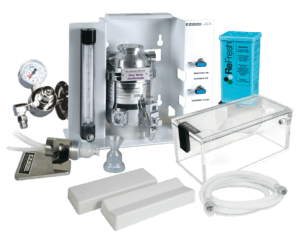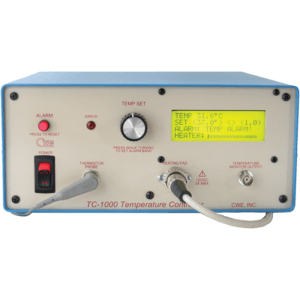SAR-1000 Advanced Volume-Pressure Ventilator- Respirator- Beatmungsgerät
The SAR-1000 Volume-Pressure Ventilator operates as a volume or pressure-cycled ventilator for mice, rats and guinea pigs and an optional upgrade is available to accommodate rabbits. VOLUME mode delivers a fixed tidal volume on each breath, and PRESSURE mode causes inflation to stop at a preset airway pressure. In either mode, lung inflation is maintained at the end of inspiration until the percent inspiration (%Insp) time has elapsed.
SAR-1000 Advanced Volume-Pressure Ventilator- Respirator- Beatmungsgerät
Für ausführliche Informationen in Deutsch kontaktieren Sie bitte Ihren Kundenberater!
The Volume-Pressure Ventilator operates as a volume or pressure-cycled ventilator for rats, rabbits and guinea pigs and an optional upgrade is available to mice.
Features and benefits:
- Wide tidal volume and rate change
- User friendly set-up and operation
- Accommodates mice up to guinea pigs
- Direct display of Tidal Volume and all parameters
- Remote control via USB port
- Multi-animal set-up available
- Safe for use with oxygen and anaesthetic gases
technical information:
- Respiratory rate range: 5 – 200 breaths/min
- Tidal volume range: 0.2 – 35 ml
- Inspiration/expiration range (%Insp): 10 – 90%
- Inspiratory flow rate range: 100 – 1000ml/min
- Pressure control range: 0 – 50 cmH20
- internal air-pump caspacity: 3 LPM @ 5 PSI (0,34 bar)
- Analogue pressure output voltage: 50mV/cmH20
- Logic Sync Out voltage: 5 V (TTL)
- Trigger In voltage: 5 v (TTL)
- Remote-control interface: USB
- Front panel ports: Luer female
- Rear panel ports: 0.15” flex tubing barb (4 mm)
- Power requirements: 120/240 VAC, 50 A
- Dimensions: 9” Lx 9” W x 4” H
Verwandte Produkte
EZ-SA800 Single Animal System

Das EZ-SA800- Single Animal System ist für Tiere von Neugeborenen bis zu Kaninchen geeignet und dient zur Narkose von jeweils einem Tier. Es verfügt über 2 Ventile, mit denen der Anästhesieausgang zur Induktionskammer und / oder zum Atemkreislauf geleitet werden kann.
Rektales Temperatur Überwachungssystem

Das Rektale Temperatur Überwachungssystem überwacht und regelt die Körpertemperatur des Tieres über einen Temperaturfühler. Der Temperaturfühler gibt eine Rückmeldung an einen Regler, der die Temperatur über eine Heizmatte ständig anpasst. Das System ist für die Verwendung mit Ratten, Mäusen oder Kaninchen / Katzen ausgelegt, eine Heizmatte pro System.
MRI-1 Ventilator

The MRI-1 Ventilator is a small animal ventilator designed for use in MRI and other high magnetic field environments. The system comprises a microprocessor-based control unit and a set of remote, pneumatically operated, non-metallic valves. The MRI-1 can operate by itself or can be controlled and/or monitored by a computer.
The MRI-1 operates on the flow-time principle: an inspiratory airflow is established and gated into the animal for a known time, thus producing a known volume. This approach provides extraordinary flexibility — a wide range of volumes, breaths-per-minute, and I/E ratios are possible with no hardware changes, and using just three front-panel controls.
Respiratory airflow is provided by an internal airpump. Alternatively, an external pressurized gas source can be attached (oxygen or anesthetic gasses). The remote high-speed, miniature pneumatic valves do the actual airflow switching. By locating these valves close to the animal (including inside the magnet bore if necessary), dead-space and tubing compliance are minimized.
